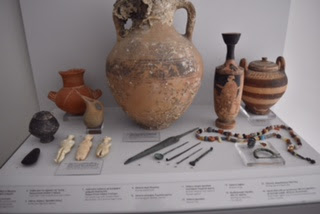Pythagorio
Again our trusty scooter took us on another adventure, we travelled to the town of Pythagorio. About a 30 - 40 min ride. Previously this township was named Tigani, however in 1955 it was renamed to honour Pythagoras. Pythagoras was a Greek philosopher and mathematician most famous for his phythagoreon theroem. He was born in 570BC in ancient Samos.
The township of Pythagorio is built upon the ruins of the old city of Samos and some of the ruins are incorporated into the current modern buildings.
Our first stop was the
Archeological museum of Pythagorio
This museum was fabulous, every item was labelled clearly with its origins and date. Throughout the museum there were large information boards identifying the different periods of the items.
These were amazing dating to around 550BC you can see in the front medical equipment including a pair of tweezers. So finely made and so petite.
The museum also included some ruins of ancient Samos including this stunning mosaic, and another on the floor of what would have been a bath house.
The collection came from sites all over Samos, but mainly from the Temple of Hera and are believed to be offerings from pilgrims, the collection also included Greek and Roman statues. There is a bust of Augustus Octavious, the one above is believed to have been a Roman prince name unknown.
After leaving the museum we headed out to
The temple of Hera (Heraion)
Founded on the site of the mythological birth of the goddess Hera, the Herion is one of Greece's most important sites. The Temple is believed to be the first of the gigantic free-standing Ionic temples built in Greece , and was the third temple built to honour Hera on this site and is believed to have been never finished. The column you see above it the last of the over 100 columns believed to have been there.
After leaving Hera's temple we headed to the
Eupalinus Tunnel
I know this image isn't great but if you look through the grate you can see a small tunnel deep down.
The eupalinus tunnel is the middle section of the ancient city of Samos's aqueduct. It was built during the 6th century BC and was one of the most significant technical achievements of antiquity.
One of the most amazing things about this tunnel is that it was simultaneously dug from the north and south and the image above it where they met in the middle. As you can imagine in those days there was no mechanical devices to help so this tunnel was hewn by hand by teams of stone masons. The aqueduct itself was a smallish clay pipe which unfortunately blocked repeatedly due to the high calcium levels in the water, however they unblocked it when necessary and The aqueduct provided water to ancient Samos for over 1000 years. During 627 and 666 AD and the tunnels provided sanctuary to Samian's during the Persian and Arabic raids.
We then popped up and had a look at a nearby monastery, it was in the most beautiful spot and it's original church was down inside a cave.
And finally after a very late lunch we went to the Port of Pythagorio. Which is actually the harbour of ancient Samos, and remnants of the ancient harbour still exists today.
Above is the new city of Samos, we really didn't head down into there at all.
Happy to while our hours away in Kokkari,
other than when we got the got to go see something bug.
Kalimera
Googy Girl












Comments